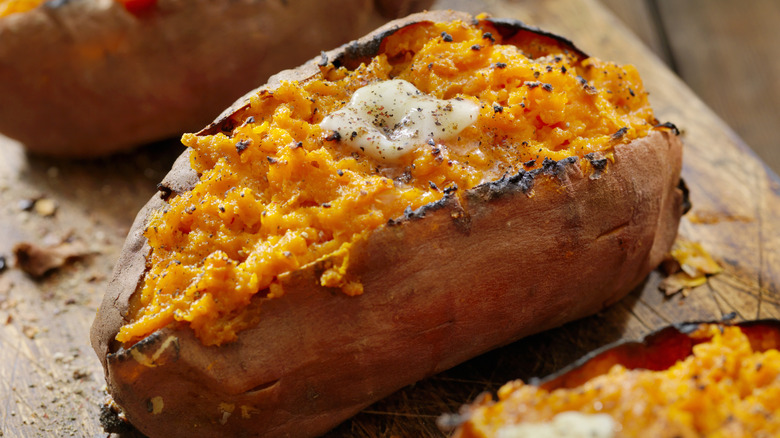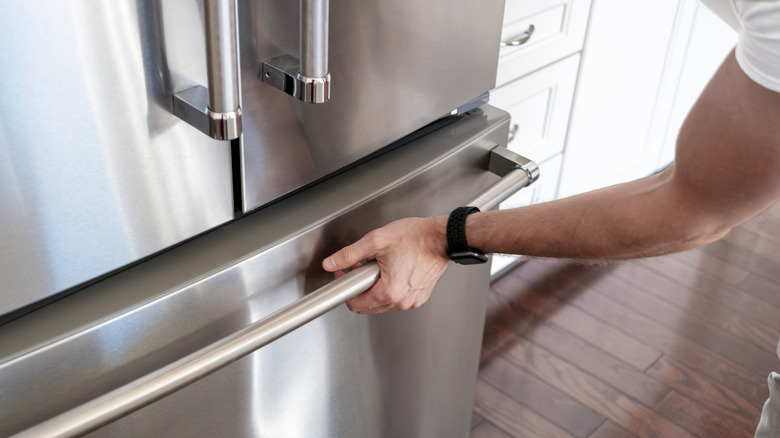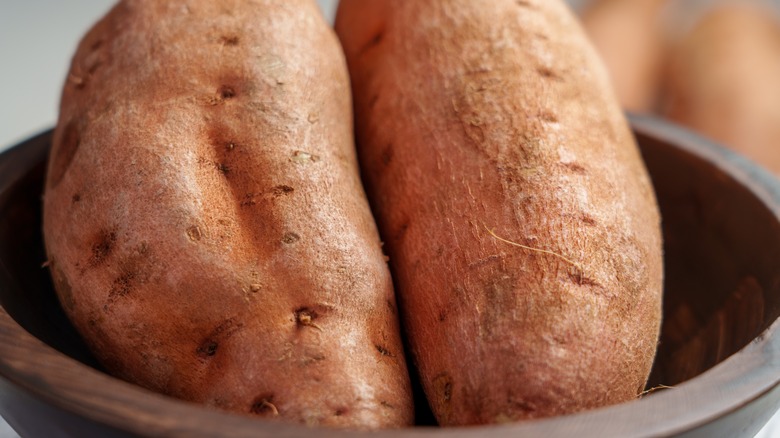For The Best Baked Sweet Potatoes, Your Freezer Is Key
A sweet spin on the classic baked potato, baked sweet potatoes make for a delicious side dish or snack. Topped with butter, some cinnamon, or even a mix of herbs and cheeses, these tubers are both versatile and nutritious. But for the absolute best baked sweet potatoes that are caramelized on the outside and fluffy on the inside, your freezer is key.
That might sound counterintuitive. After all, how does freezing an ingredient first somehow yield a more tender and flavorful end product? But the freezer method of baking sweet potatoes is tried and true. It essentially forces out all of the moisture inside the potato, leaving the dense flesh to roast up into a light and airy consistency when baked.
Here's how to do it. First, wash and scrub the sweet potatoes and allow them to dry fully. Pop them into the freezer for a minimum of three hours. Remove them from the freezer, wrap tightly in aluminum foil, and bake in the oven for two hours. You can set the oven to 300 degrees Fahrenheit but there is no need to wait for it to preheat before adding the potatoes, as they'll cook while the oven comes to temperature. If you want a nice and caramelized outer skin, remove the foil and dial up the temperature for the last 30 or 40 minutes.
Why the freezer method works
The freezer method is a take on the traditional way sweet potatoes were served in China and Hong Kong as a street-side snack cooked in a wok after being plucked nearly frozen from the fields. The technique falls in line with much of Chinese cooking, which often seeks to rid ingredients of excess water. "One of the core tenets of Chinese cooking is that water is flavorless," Lucas Sin of Junzi Kitchen told Eater. "So a lot of Chinese technique is to force the water out of something so that what's left behind is the more concentrated essence of that ingredient."
Freezing turns the inside of the sweet potato to ice, causing the cell walls to rupture, Sin explained. The science behind how this method yields a fluffier sweet potato lies in the makeup of the potato flesh itself. Sweet potatoes are already rich in a naturally occuring sugar called maltose, but they become even more so when frozen because of an enzyme called amylase. Amylase, which is responsible for turning glycogen into simple sugars, transforms the starch within the potato into maltose. All these sugars get trapped between the potato skin and the flesh when baking, resulting in a caramelized outer skin and tender insides.
Sweet potato mistakes to avoid
Besides the freezer method, there are some other sweet potato best practices to follow and mistakes to avoid. One of the mistakes everyone makes when cooking sweet potatoes is storing them in the fridge whole and unpeeled before preparing them. The refrigerator is too cold and will turn the center of the sweet potatoes hard and could even affect the taste. It's better to store them in a dry, cool place and out of any direct heat. They should keep for about two weeks when stored properly.
Boiling your sweet potatoes is another mistake to avoid. When you boil these tubers, you lose out on all the yummy caramelization that develops as the Maillard reaction works its magic, creating delicious and deep flavors. It can also affect the texture, creating a mushy, waterlogged interior.
Those are the things you've probably been doing all wrong. Your best bet is to roast or bake sweet potatoes for optimal taste and texture. Make sure to leave them whole, too. Slicing them in half could potentially dry them out.


